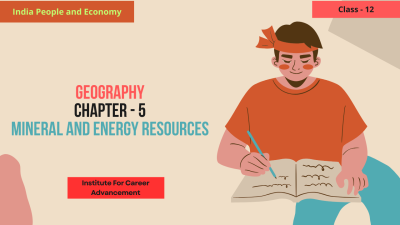Mineral and Energy Resources - Class 12
 Compare
Compare
Mineral resources are inorganic substances found in the Earth's crust. They are essential for various industries and our daily lives. These resources can be classified into two main categories:
Metallic minerals: These contain metals, such as iron, copper, gold, and aluminum. They are used in manufacturing, construction, and technology.
Non-metallic minerals: These do not contain metals, such as coal, petroleum, natural gas, limestone, and mica. They are used for energy production, construction materials, and industrial processes.
Energy resources are the sources of power used to perform various tasks. They can be classified into two types:
Renewable energy resources: These can be replenished naturally, such as solar, wind, hydro, geothermal, and biomass.
Non-renewable energy resources: These are finite and cannot be regenerated within a human lifespan, such as coal, petroleum, and natural gas.
Geographic distribution: India is rich in various mineral and energy resources, including iron ore, coal, bauxite, and natural gas. However, it also faces challenges such as depletion of some resources and dependence on imports for others.
By understanding the concepts of mineral and energy resources, their distribution, and the challenges associated with their use, students can develop a deeper appreciation for the importance of these resources in our society and the need for sustainable practices.
খনিজ সম্পদ হল পৃথিবীর ভূত্বকের মধ্যে পাওয়া অজৈব পদার্থ। এগুলি বিভিন্ন শিল্প এবং আমাদের দৈনন্দিন জীবনের জন্য প্রয়োজনীয়। এই সম্পদগুলিকে দুটি প্রধান বিভাগে শ্রেণীবদ্ধ করা যেতে পারেঃ
ধাতব খনিজঃ এগুলিতে লোহা, তামা, সোনা এবং অ্যালুমিনিয়ামের মতো ধাতু থাকে। এগুলি উৎপাদন, নির্মাণ এবং প্রযুক্তিতে ব্যবহৃত হয়।
অ-ধাতব খনিজঃ এগুলিতে কয়লা, পেট্রোলিয়াম, প্রাকৃতিক গ্যাস, চুনাপাথর এবং অভ্রের মতো ধাতু থাকে না। এগুলি শক্তি উৎপাদন, নির্মাণ সামগ্রী এবং শিল্প প্রক্রিয়াগুলির জন্য ব্যবহৃত হয়।
শক্তি সম্পদ হল শক্তির উৎস যা বিভিন্ন কাজ সম্পাদনের জন্য ব্যবহৃত হয়। এদেরকে দুই শ্রেণীতে ভাগ করা যায়ঃ
পুনর্নবীকরণযোগ্য শক্তি সম্পদঃ এগুলি প্রাকৃতিকভাবে পুনরায় পূরণ করা যেতে পারে, যেমন সৌর, বায়ু, জলবিদ্যুৎ, ভূ-তাপীয় এবং জৈববস্তুপুঞ্জ।
অ-পুনর্নবীকরণযোগ্য শক্তি সম্পদঃ এগুলি সীমাবদ্ধ এবং কয়লা, পেট্রোলিয়াম এবং প্রাকৃতিক গ্যাসের মতো মানুষের জীবনকালের মধ্যে পুনরুত্পাদন করা যায় না।
ভৌগোলিক বণ্টনঃ ভারত লৌহ আকরিক, কয়লা, বক্সাইট এবং প্রাকৃতিক গ্যাস সহ বিভিন্ন খনিজ ও শক্তি সম্পদে সমৃদ্ধ। তবে, এটি কিছু সম্পদ হ্রাস এবং অন্যদের জন্য আমদানির উপর নির্ভরতার মতো চ্যালেঞ্জেরও মুখোমুখি হয়।
খনিজ ও শক্তি সম্পদের ধারণাগুলি, তাদের বিতরণ এবং তাদের ব্যবহারের সাথে সম্পর্কিত চ্যালেঞ্জগুলি বোঝার মাধ্যমে, শিক্ষার্থীরা আমাদের সমাজে এই সংস্থানগুলির গুরুত্ব এবং টেকসই অনুশীলনের প্রয়োজনীয়তার জন্য গভীর উপলব্ধি বিকাশ করতে পারে।



















